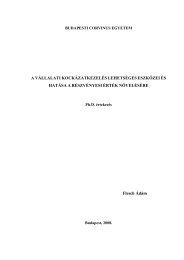római kori villák történeti - Budapesti Corvinus Egyetem
római kori villák történeti - Budapesti Corvinus Egyetem
római kori villák történeti - Budapesti Corvinus Egyetem
You also want an ePaper? Increase the reach of your titles
YUMPU automatically turns print PDFs into web optimized ePapers that Google loves.
latinfundium belonged to the villas in each case: from the size and quality of the buildings<br />
we could draw conclusions regarding the size of the property. The typical size of the<br />
estates on Balaton Highland could be the medium-sized estate of 20-125 hectares.<br />
The landscape is the witness of history: the people of different ages have changed the<br />
environment according to their own desire. Therefore interdisciplinary landscape<br />
archaeology could help to get to know the past. The scientific objects of the landscape<br />
archaeological researches are the contact of the former-land and the way of living. The<br />
scientific objects of the landscape archaeological researches are the contact of the formerland<br />
and the way of living. The goal of these researches is mapping and placing of the<br />
archaeological objects.<br />
Environmental archaeology is a fast developing multidisciplinary science in our<br />
time, the researches of which are based on comparing archaeological, historical data, and<br />
also maps and the terrain. The connections of so-called earth covered monuments (for<br />
example roads, buildings) could be explored with the help of the modern relief, from which<br />
conclusions could be drawn to the presumable historical landscape. A gradual approach<br />
change can be observed in the Central European archaeology in the past decades: not only<br />
the archaeological objects, but the environment of these comes to the front, open to the<br />
scale of landscape. The human activity has a powerful effect on its environment in every<br />
Ages. With the disappearance of the different using modes, the nature still retaines the<br />
tracks of these activities, though the intervention of the later Ages (for example ploughing,<br />
settling on), or the changes after natural forces (e. g. erosion) cause new changes, which<br />
could be usually separated.<br />
The Balaton Highland was particularly suitable for settling, for the villas and<br />
other settlements with rural character (the so-called vicus), building for agricultural and<br />
handicraft production. I determined my study area in a 16 km wide zone around the<br />
eastern, northern and western shore of the Lake Balaton: cities were not developed in this<br />
zone, this way I may have a clear view about the rural life form while the examination of<br />
the find places without urban settlement forms.<br />
I examined the environment of 189 sites found in the volumes of Magyarország<br />
Régészeti Topográfiája (Archaeological Topography of Hungary) and other archaeological<br />
literatures: the description of the environment are usually succinct in these materials, the<br />
authors relied on describing primarily the surface phenomena (e. g. debris) at determining<br />
the objects. Fundamental changes in the terrain can not be calculated in the last one and a<br />
half millennia: only some radical anthropogenic interferences were generated in this zone,<br />
133

















